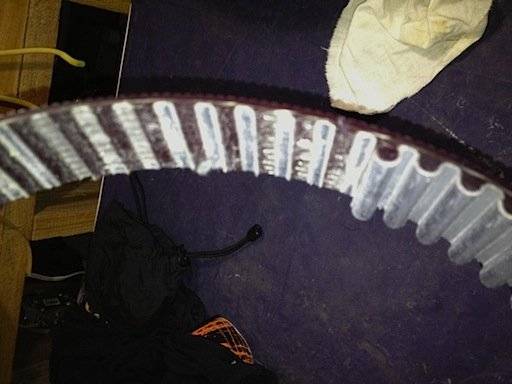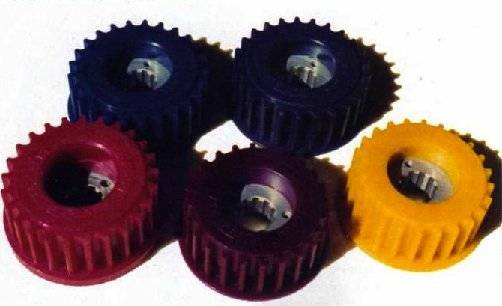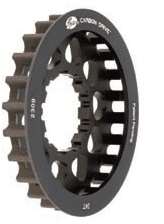SOME THOUGHTS ON QuickDrive® BELT ISSUES
Here is my take on SOME of the belt quandry out there... This may be more than you care to read.
There have been a few photos posted of sheared final-drive belt teeth on some Polaris QuickDrive equipped 2013 PRO RMK's.
So that we are clear... There are only a FEW documented issues of stripped belt teeth at this point in time. This is not a widespread observation .. but certainly one that is much discussed lately.
There are plenty of riders out there on their 2013 PRO RMK's that have not had any issues with their QuickDrive belts... including some turbo riders like Matt Entz and Erik Woog.


Also, I hope that the P.I. engineers that may read this do not take this in any kind of an offensive way.. and If the assumptions I make here are off-base...please contact me by email or PM and I will make the necessary corrections.
I have also heard that Chris Burandt and Polaris RMK engineers that there had been some sheared tooth belt failures during development, and that this was worked out on production sleds for the 2013 MY.
The engineers said that the only "failure mode" that they saw with the QuickDrive belts was with seared teeth while under abnormally high shock loads well beyond the normal operation of sleds by consumers.
I believe these QuickDrive belt failures only represent a small portion of the units out there and for the most part, the QuickDrive will be trouble free....AND in the end.. only time will tell and we should have an accurate picture of system durability.
I have some, limited, design experience with Gates Poly Chain GT drive systems, outside of the snowmobile world.
The most recent drive CMX drives using the Gates Poly Chain drive have not experienced sheared toot failres that I have heard of... But the CMX system is a very different design than that of the QuickDrive. The C3 drive also differs in that it has a tensioner.
The tensioner as equipped on CMX and C3 drives, IMO, does NOT have as its primary function to adjust for a stretched belt.
Except for a minute initial & Permanent stretch... The Gates Carbon Poly Chain belts do not stretch for all intents and purposes... they will break before they stretch to any significant degree.
The primary advantage of a tensioner is to accommodate mfg. tolerances and tolerance-stacking inherent in a fixed Center Design and to accomodate different drive ratios.
Accurate tensioning methods will be crucial to getting proper performance from aftermarket drives... And is one of the reasons that some of the belts on older CMX drives were breaking...installer error in proper tension.
I also like the use of an inside idler/tensioner of the CMX drive compared to the backside tensioner of the C3 drive in terms of reliability.
Note: A tensioner can help to adjust for tension issues in a "fixed center" design and provide more optimal tooth engagement in cases where tolerance stacking, variations in manufactured measurements are present.
In effect, this changes the design to a hybrid-non-fixeddesign that can be adjusted to accommodate these variances.
Here are some of my theory's for these few belt failures that have appeared in consumers sleds.
1) The demo and Press units that were used last season were hand built units. Yes, they were made on the production line according to Polaris and I trust this info. But they would receive extra care and the original parts are most likely individually checked for tolerance in mfg. Which leads to...
2) Tolerance built into drive to accommodate fixed center. As you will read below.. over tensioning of a belt is the worst case for these belts... but a loose belt can also overly self tension.
By design, and as indicated by the fact that you can slide (using the guide tools) a belt/sprocket onto the shafts when unloaded... the factory has built in a bit of looseness to the system to accommodate tolerance issues.
Some of the belts that are shearing teeth may be a victim of this or the minor off-spec situations that are inherent in ANY mfg process of mass produced vehicles.
We are talking about 0.002" - 0.003" here!
I believe that the urethane drive sprockets that have been successfully used in Harley Davidson drive sprockets could be very helpful in this situation... they have enough "give" to allow for these minor off-spec issues (C 2 C dimensional variation) and also absorb shock loads of sudden braking, reverse spikes, or instant track loading from jumping etc.
The sprockets that are offered by http://www.supermax.net/ are a good example of this type of sprocket.. and there is a great technical discussion here as well... check it out.

3) Operational-environment concerns... At high shaft and belt speeds debris or even water that could cause "hydroplaning" of the belt at high belt speeds causing over tension. This is not present in the final drives of belt-driven road bikes because of the relatively lower belt speeds of a large diameter tire/wheel.
This is where I believe that the use of vented or ported sprockets would be helpful. Unvented sprockets, may not allow for the exit of water/ice quickly enough to prevent hydraulic lifting of the belt around the contact-arc of the belt on the pulley... which could result in a destructive over-tensioning situation simultaneously occurring with less belt to sprocket engagement.

4) Drive shaft wobble or bent drive shaft.
If the QuickDrive end of the driveshaft is not true and has some wobble to it... the belt will cycle through over and under tensioned issues. A new driveshaft that has suffered impact damage will run "out of round" at the sprocket... A simple dial indicator can verify how true the shaft is running.
Even a hit that only temporarily deflected the shaft can cause an over-tension situation to occur and could cause a situational failure of the belt or bearings.
Impact damage is more likely in a drop/roll situation where the drivers/shaft are more exposed to impacts than a stock installation. In this case... a D&R mfg may want to consider a bash plate/wedge in front of the driveshaft to minimize the possiblilty of impact damage/bending.
In the end, I still believe that most will have trouble free operation of their sleds this year...This is a discussion for those people that have posted sheared belt issues. I'm also confident that P.I. will cover most these low mileage belt faliures under warranty on a case-by-case basis.
Here is my take on SOME of the belt quandry out there... This may be more than you care to read.
There have been a few photos posted of sheared final-drive belt teeth on some Polaris QuickDrive equipped 2013 PRO RMK's.
So that we are clear... There are only a FEW documented issues of stripped belt teeth at this point in time. This is not a widespread observation .. but certainly one that is much discussed lately.
There are plenty of riders out there on their 2013 PRO RMK's that have not had any issues with their QuickDrive belts... including some turbo riders like Matt Entz and Erik Woog.

Also, I hope that the P.I. engineers that may read this do not take this in any kind of an offensive way.. and If the assumptions I make here are off-base...please contact me by email or PM and I will make the necessary corrections.
I have also heard that Chris Burandt and Polaris RMK engineers that there had been some sheared tooth belt failures during development, and that this was worked out on production sleds for the 2013 MY.
The engineers said that the only "failure mode" that they saw with the QuickDrive belts was with seared teeth while under abnormally high shock loads well beyond the normal operation of sleds by consumers.
I believe these QuickDrive belt failures only represent a small portion of the units out there and for the most part, the QuickDrive will be trouble free....AND in the end.. only time will tell and we should have an accurate picture of system durability.
I have some, limited, design experience with Gates Poly Chain GT drive systems, outside of the snowmobile world.
The most recent drive CMX drives using the Gates Poly Chain drive have not experienced sheared toot failres that I have heard of... But the CMX system is a very different design than that of the QuickDrive. The C3 drive also differs in that it has a tensioner.
The tensioner as equipped on CMX and C3 drives, IMO, does NOT have as its primary function to adjust for a stretched belt.
Except for a minute initial & Permanent stretch... The Gates Carbon Poly Chain belts do not stretch for all intents and purposes... they will break before they stretch to any significant degree.
The primary advantage of a tensioner is to accommodate mfg. tolerances and tolerance-stacking inherent in a fixed Center Design and to accomodate different drive ratios.
Accurate tensioning methods will be crucial to getting proper performance from aftermarket drives... And is one of the reasons that some of the belts on older CMX drives were breaking...installer error in proper tension.
I also like the use of an inside idler/tensioner of the CMX drive compared to the backside tensioner of the C3 drive in terms of reliability.
Note: A tensioner can help to adjust for tension issues in a "fixed center" design and provide more optimal tooth engagement in cases where tolerance stacking, variations in manufactured measurements are present.
In effect, this changes the design to a hybrid-non-fixeddesign that can be adjusted to accommodate these variances.
Here are some of my theory's for these few belt failures that have appeared in consumers sleds.
1) The demo and Press units that were used last season were hand built units. Yes, they were made on the production line according to Polaris and I trust this info. But they would receive extra care and the original parts are most likely individually checked for tolerance in mfg. Which leads to...
2) Tolerance built into drive to accommodate fixed center. As you will read below.. over tensioning of a belt is the worst case for these belts... but a loose belt can also overly self tension.
By design, and as indicated by the fact that you can slide (using the guide tools) a belt/sprocket onto the shafts when unloaded... the factory has built in a bit of looseness to the system to accommodate tolerance issues.
Some of the belts that are shearing teeth may be a victim of this or the minor off-spec situations that are inherent in ANY mfg process of mass produced vehicles.
We are talking about 0.002" - 0.003" here!
I believe that the urethane drive sprockets that have been successfully used in Harley Davidson drive sprockets could be very helpful in this situation... they have enough "give" to allow for these minor off-spec issues (C 2 C dimensional variation) and also absorb shock loads of sudden braking, reverse spikes, or instant track loading from jumping etc.
The sprockets that are offered by http://www.supermax.net/ are a good example of this type of sprocket.. and there is a great technical discussion here as well... check it out.
3) Operational-environment concerns... At high shaft and belt speeds debris or even water that could cause "hydroplaning" of the belt at high belt speeds causing over tension. This is not present in the final drives of belt-driven road bikes because of the relatively lower belt speeds of a large diameter tire/wheel.
This is where I believe that the use of vented or ported sprockets would be helpful. Unvented sprockets, may not allow for the exit of water/ice quickly enough to prevent hydraulic lifting of the belt around the contact-arc of the belt on the pulley... which could result in a destructive over-tensioning situation simultaneously occurring with less belt to sprocket engagement.
4) Drive shaft wobble or bent drive shaft.
If the QuickDrive end of the driveshaft is not true and has some wobble to it... the belt will cycle through over and under tensioned issues. A new driveshaft that has suffered impact damage will run "out of round" at the sprocket... A simple dial indicator can verify how true the shaft is running.
Even a hit that only temporarily deflected the shaft can cause an over-tension situation to occur and could cause a situational failure of the belt or bearings.
Impact damage is more likely in a drop/roll situation where the drivers/shaft are more exposed to impacts than a stock installation. In this case... a D&R mfg may want to consider a bash plate/wedge in front of the driveshaft to minimize the possiblilty of impact damage/bending.
In the end, I still believe that most will have trouble free operation of their sleds this year...This is a discussion for those people that have posted sheared belt issues. I'm also confident that P.I. will cover most these low mileage belt faliures under warranty on a case-by-case basis.
Last edited:


